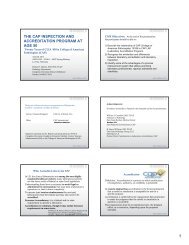Improving Blood Culture Sensitivity WHEN AND WHY Blood ...
Improving Blood Culture Sensitivity WHEN AND WHY Blood ...
Improving Blood Culture Sensitivity WHEN AND WHY Blood ...
You also want an ePaper? Increase the reach of your titles
YUMPU automatically turns print PDFs into web optimized ePapers that Google loves.
Growth Possibilities Subculture to<br />
Tiny Gram<br />
Neg. Bacilli<br />
Haemophilus<br />
Brucella<br />
Anaerobic Gram<br />
Neg. Rod<br />
Choc Agar (CO 2 )<br />
Anaerobic Agar<br />
Direct Latex<br />
Direct Latex Technique<br />
(Mallow, et al., ICAAC 1987 ABST. #206<br />
• Centrifuge blood culture fluid at low speed<br />
to sediment RBC’s.<br />
• Heat at 100°C for 10 minutes in 3 volumes<br />
of EDTA to destroy interfering factors.<br />
• Clarify by centrifugation and test<br />
supernatant for antigen of bacteria seen<br />
on blood culture fluid gram stain.<br />
Growth Possibilities Subculture to<br />
Gram Positive Cocci<br />
(pairs or in chains)<br />
Strep. Pneumoniae<br />
Strep. Bovis<br />
Beta Strep<br />
Strep. Viridans<br />
Anaerobic Strep<br />
Others<br />
Direct Latex<br />
BAP w/Optochin &<br />
Bacitracin Disks<br />
Bile Esculin Slant<br />
Anaerobic Agar<br />
Gram Pos. Cocci<br />
(in chains or pairs)<br />
• Bile esculin positive, PYR positive Enterococcus<br />
GU tract, endocarditis requires gentamicin plus<br />
ampicillin or vancomycin.<br />
• Bile esculin positive, PYR negative possible<br />
Strep. Bovis. Endocarditis, CA of colon. No<br />
resistance to penicillin, cephalosporin.<br />
• Bile esculin negative – Other penicillin and<br />
cephalosporin sensitive streptococcus.<br />
After Hours Communication of<br />
Positives<br />
• Gram-negative rods are rarely contaminants, and<br />
there is high mortality due to shock and bleeding.<br />
• Laboratory contacts attending nurse, who<br />
immediately contacts the physician, regardless of<br />
time of day or night.<br />
• Gram-positive cocci and other bacteria are<br />
occasionally contaminants. Most antibiotics kill grampositive<br />
cocci.<br />
• Laboratory contacts nurse, who calls physician only if<br />
patient appears septic (e.g., fever and/or shock) and<br />
is not on an antibiotic. Physician not contacted after<br />
hours if patient is stable and on an antibiotic.<br />
<strong>Blood</strong> <strong>Culture</strong> Methods<br />
•Isolator<br />
• Instrument methods<br />
• Conventional bottles<br />
6




